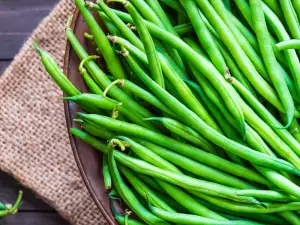Green beans (Phaseolus vulgaris) are an annual plant, whose season is from June to the autumn months of August to October. Green beans are actually immature fruits of beans, being the pods and seeds hidden in them. It is in an extremely sensitive to cold plant, it likes moisture and moderate sunshine.
Green beans are a widespread arable crop, having grown in greenhouses, where they are picked between April and December. The world has grown more than 100 varieties of beans, and the scale is growing in Europe and Africa - in Germany, Italy, Spain, Holland, Turkey, Egypt.
Green beans are considered one of the oldest cultivated plants and is native to Africa and shows Asia. Excavations testified that in South America and Mexico from seed are grown corn, squash and beans, as early as 3000 BC
A prerequisite for quality beans is there to be "no threads". The first type of this bean is cultivated in distant 1894 by Calvin Keeney, called the father of this type of bean. Green beans are not only popular on the continent, but in Africa too. In the U.S. it is one of the ingredients required for dishes for Thanksgiving. There are two main varieties of green beans - and climbing non- climbing plants.

Composition of green beans
Green beans are a very good source of vitamin A and vitamin C. A portion of green beans can supply your body 17% of the daily recommended dose of vitamin A and 20% of your needs for vitamin C. Moreover, this legume is rich in dietary fiber or fiber, low in calories and contains some doses of iron and potassium.
The calories from fat entering the body of the beans are only equal to 1 kcal. One full cup of beans contains 2 grams of protein. Good to know that green beans alone can not meet the nutritional needs of a person. It is consumed as a supplement to a main dish or salad.
This legume low in sodium, and very low in saturated fat and cholesterol. It is also a good source of protein, thiamin, riboflavin, niacin, vitamin B6, calcium, magnesium, phosphorus, copper, and a great source of vitamin K, folate and manganese.
100 grams of green beans contain:
Energy - 129 kJ (31kcal)
Carbohydrates - 7.1 g
Fiber - 3.6 g
Sugars - 3.26
Fat - 0.1 g
Protein - 1.8 g
Vitamin C - 16 mg (27%)
Iron - 1 mg (8%)
Potassium - 200 mg (4%)
Water - 90 ml

About 100 grams of canned green beans will have:
Energy - 15 kcal
Carbohydrates - 3.50 grams
Fiber - 1.50 g
Sugars - 0 g
Fat - 0.10 g
Protein - 0.80 g
Vitamin C
Iron
Potassium
Water - 95 ml
Selecting and storing beans
It is important to choose fresh green beans because they do not taste good and it is hard to make. When selecting green beans, pods are to have no brown spots or lesions and wrinkles. It is essential that the pods are not soft and easily breakable. This is a sure sign that the product is fresh and the utmost nutritional value is preserved.
The duration of storage of green beans is not large. Like most fresh vegetables, they can fade in 2 days, lose their fresh green color and develop specks. Keep it for 2-3 days in the lower box of the fridge, in a suitable bag. If you want to extend its shelf life, it can be blanched in salted water, and with the addition of a little baking soda, the color will remain saturated. Then put it in a plastic box with a lid and freeze.

Cooking beans
To prepare beans for cooking, you must clean them. Using a knife cut the tip on both sides of the pod and rinse. Cook green beans as a side dish and a popular addition to a variety of salads, meat and fish. With green beans are cooked stews, casseroles and winter supplies. Among the products and spices that combine with green beans well, are savory, onion, garlic, smoked bacon, parsley, thyme and marjoram. Steamed with other vegetables, green beans are a perfect garnish.
Benefits of green beans
Green beans are diet food because they contain very few calories and are rich in essential for human health, vitamins and minerals. It is one of the products that regularly attend our table, it has the ability to strengthen the immune system and improves metabolism due to its composition.
Green beans are suitable food for people who suffer from diabetes. It also helps with high blood pressure and urinary infections. Folk medicine recommends that against these diseases, you use a decoction of dried shells of green beans.
Dangers of beans
According to experts, raw green beans are inadvisable to eat raw, because there is still the presence of toxic protein. Most of this protein is found in young grain and with its consumption, gastrointestinal disorders may occur.
However, the toxic proteins are transformed into harmless after cooking. It is best to steam green beans for at least 10 minutes to ensure that there are no traces of the toxin, and it is completely dissolved.




















Comments